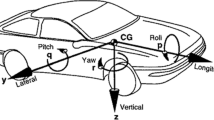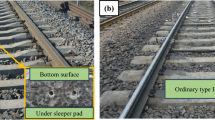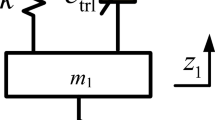Abstract
An active steering bogie is designed to for yaw control of the wheel-sets to align the wheels with the track direction during curve negotiation. Existing control laws for active steering are developed by assuming new wheels and rails, and known vehicle and track layout, but do not include the vehicle speed as an input variable. As wheels wear and vehicle speed varies, such static control law may not be optimal. In this paper, the time-varying cant surplus/ deficiency information are adapted into a modified active steering control law. Multi-body simulation results show reduced wheel wear, and increase in passenger comfort, operating speed and wheel life due to the proposed adaptive steering control law.
Similar content being viewed by others
References
R. Illingworth and M. G. Pollard, The use of steering axle suspension to reduce wheel and rail wear in curves, Proc. Inst. Mech. Engrs., 196 (1982) 379–385.
T. X. Mei and R. M. Goodall, Modal controllers for active steering of railway vehicles with solid axle wheel-sets, Veh. Syst. Dynam., 34 (2000) 24–31.
G. Shen and R. M. Goodall, Active yaw relaxation for improved bogie performance, Veh. Syst. Dynam., 28 (1997) 273–282.
J. Perez, J. M. Busturia and R. M. Goodall, Control strategies for active steering of bogie-based railway vehicles, Control Eng. Pract., 10 (2002) 1005–1012.
J. Guo, Z. Xu and Y. Sun, A new semi-active safety control strategy for high-speed railway vehicles, Veh. Syst. Dynam., 53(12) (2015) 1918–1934.
S. Shen, T. X. Mei and R. M. Goodall, A study of active steering strategies for railway bogie, Veh. Syst. Dynam., 41 (2004) 282–291.
J. Kalker, Three-dimensional Elastic Bodies in Rolling Contact, Chapter 3: Simplified Theory of Contact, Springer Science & Business Media, London (1990).
J. B. Ayasse and H. Chollet, Determination of the wheel rail contact in semi-Hertzian conditions, Veh. Syst. Dynam., 43(3) (2005) 161–172.
J. Piotrowski and W. Kik, A simplified model of wheel/rail contact mechanics for non-Hertzian problems and its application in rail vehicle dynamic simulations, Veh. Syst. Dynam., 46 (2008) 27–48.
J. J. Kalker, Simplified theory of rolling contact, Delft Progress Report 1, Series C: Mechanical and Aeronautical Engineering and Ship Building (1973) 1–10.
J. J. Kalker, A fast algorithm for the simplified theory of rolling contact, Veh. Syst. Dynam., 11(1) (1982) 1–13.
K. S. Song et al., Effect of conicity on lateral dynamic characteristics of railway vehicle through scaled wheelset model development, Journal of Mechanical Science and Technology, 32(11) (2018) 5433–5441.
J. Ding et al., Application of the semi-Hertzian method to predict of wheel wear in heavy haul freight car, Wear, 312 (2014) 104–110.
G. Tao et al., Effect of wheel-rail contact modeling on wheel wear simulation, Wear, 366 (2016) 146–156.
J. Blanco-Lorenzo, J. Santamaria, E. G. Vadillo and E. N. Correa, On the influence of conformity on wheel-rail rolling contact mechanics, Tribol. Int., 103 (2016) 647–667.
X. Jin, X. Xiao, Z. Wen, J. Guo and M. Zhu, An investigation into the effect of train curving on wear and contact stresses of wheel and rail, Tribol. Int., 42(3) (2009) 475–490.
Y. Ma, V. Markine, A. A. Mashal and M. Ren, Modelling verification and influence of operational patterns on tribological behaviour of wheel-rail interaction, Tribol. Int., 114 (2017) 264–281.
N. Banerjee and R. Karmakar, Bond graph modeling of rail wheelset on curved track, Simulation, 83(10) (2007) 695–706.
N. Banerjee, A. K. Saha, R. Karmakar and R. Bhattacharyya, Bond graph modeling of a railway truck on curved track, Simul. Model Pract. Th., 17(1) (2009) 22–34.
V. Kumar, V. Rastogi and P. M. Pathak, Modelling and evaluation of the hunting behaviour of a high-speed railway vehicle on curved track, Proc. Inst. Mech. Engrs., Part F: J. Rail and Rapid Transit, 233(2) (2019) 220–236.
M. Ignesti et al., Development of a wear model for prediction of wheel and rail profile evolution in railway systems, Wear, 284-285 (2012) 1–17.
L. B. Shi, L. Ma, J. Guo, Q. Y. Liu, Z. R. Zhou and W. J. Wang, Influence of low temperature environment on the adhesion characteristics of wheel-rail contact, Tribol. Int., 127 (2018) 59–68.
J. F. Santa, A. Toro and R. Lewis, Correlations between rail wear rates and operating conditions in a commercial railroad, Tribol. Int., 95 (2016) 5–12.
Y. Shimokawa and M. Mizuno, Development of the new concept steering bogie, Nippon Steel & Sumitomo Metal Technical Report, 105 (2013) 41–47.
R. M. Goodall and T. X. Mei, Active suspensions, S. Iwnicki (Ed.), Handbook of Railway Vehicle Dynamics, CRC Press, FL (2006) 327–357.
S. Pradhan et al., Forced steering control with estimated wheel wear, Proc. International Symposium on Speed-up and Service Technology for Railway and Maglev System (STECH), Chiba, Japan (2015).
S. Shen et al., Active steering of railway vehicles: A feed forward strategy, Proc. European Control Conference (ECC), Cambridge, UK (2003) 2390–2395.
W. Zhang, D. Huanyun, S. Zhiyun and J. Zeng, Roller Rigs, S. Iwnicki (Ed.), Handbook of Railway Vehicle Dynamics, CRC Press, Florida (FL) (2006) 457–506.
J. B. Ayasse and H. Chollet, Wheel-Rail contact, S. Iwnicki (Ed.), Handbook of Railway Vehicle Dynamics, CRC Press, Florida (FL) (2006) 85–120.
N. Babu et al., New approach for prediction of influence of vehicle dynamics parameters on instability of unmanned track vehicle using robotic approach, Journal of Mechanical Science and Technology, 32(3) (2018) 1357–1365.
H. Ha and K. S. Park, Construction of simulation framework for dynamic analysis of a superconducting magnetic levitation train with flexible car bodies, Journal of Mechanical Science and Technology, 33(3) (2019) 1177–1183.
T. Jendel, Prediction of wheel profile wear-comparisons with field measurements, Wear, 253 (2002) 89–99.
R. Enblom and M. Berg, Simulation of railway wheel profile development due to wear influence of disc braking and contact environment, Wear, 258 (7-8) (2005) 1055–1063.
A. Innocenti et al., Development of a wearable model for the analysis of complex railway network, Wear, 309 (2014) 174–191.
I. Okamoto, How bogies work, Japan Railway & Transport Review, 18 (1998) 52–61.
A. K. Samantaray and S. Pradhan, Dynamic analysis of steering bogies, Handbook of Research on Emerging Innovations in Rail Transportation Engineering, IGI Global, Hershey PA, USA (2016) 524–579.
Delhi Metro Orange Line (Airport Express) Map, https://www.mapsofindia.com/maps/delhi/delhi-metro-orange-line-map.html, Last accessed 20 July (2019).
J. J. Kalker, Wheel-rail wear calculations with program CONTACT, Delft: Faculty of Mathematics and Informatics (1987) 82–02.
K. Knothe and L. T. Hung, A method for analysis of tangential stresses and the wear distribution between two elastic bodies of revolution in rolling contact, Int. J. Solids Struct., 21(8) (1985) 889–906.
C. Linder, Verschleiß von Eisenbahnrädern mit Unrundheiten, Ph.D. Dissertation, ETH Zürich, Nr. 12342 (1997).
H. Chollet, M. Sebes and J. B. Ayasse, Evolution from the Hertzian contact model to non-Hertzian conditions for fast dynamic simulations, Proc. IUTAM Symposium on Computational Methods in Contact Mechanics, Springer Netherlands (2007) 189–205.
S. Pradhan, A. K. Samantaray and R. Bhattacharyya, Application of semi-Hertzian approach to predict the dynamic behavior of railway vehicles through a wear evolution model, J. Friction and Wear, 38(6) (2017) 437–443.
S. Pradhan and A. K. Samantaray, A recursive wheel wear and vehicle dynamic performance evolution computational model for rail vehicles with tread brakes, Vehicles, 1(1) (2019) 88–114.
M. Ignesti et al., Development of a wear model for the wheel profile optimization on the railway vehicles, Veh. Syst. Dynam., 51(9) (2013) 1363–1402.
F. Braghin et al., A mathematical model to predict railway wheel profile evolution due to wear, Wear, 261(2006) (1253) 1253–1264.
S. Pradhan, A. K. Samantaray and R. Bhattacharyya, Prediction of railway wheel wear and its influence on the vehicle dynamics in a specific operating sector of Indian railways network, Wear, 406-407 (2018) 92–104.
S. Pradhan and A. K. Samantaray, Integrated modeling and simulation of vehicle and human multi-body dynamics for comfort assessment in railway vehicles, Journal of Mechanical Science and Technology, 32(1) (2018) 109–119.
V. Kumar, V. Rastogi and P. M. Pathak, Simulation for wholebody vibration to assess ride comfort of a low-medium speed railway vehicle, Simulation, 93 (2017) 225–236.
V. Kumar, V. Rastogi and P. M. Pathak, Dynamic analysis of vehicle-track interaction due to wheel flat using bond graph, Proc. Inst. Mech. Engrs. Part K: J. Multi-body Dynamics, 232(3) (2018) 398–412.
V. K. Garg and R. V. Dukkipati, Dynamics of railway vehicle systems, Chapter 3: Description of the Railway Vehicle Models and Track Geometry, Academic Press, Canada (1984) 58–102.
S. Pradhan, A. K. Samantaray and R. Bhattacharyya, Multistep wear evolution simulation method for the prediction of rail wheel wear and vehicle dynamic performance, Simulation, 95(5) (2019) 441–459.
Q. Xiao et al., Research on influence of harmonic wear wheel on wheel/rail contact geometry of high-speed train, Journal of Mechanical Science and Technology, 33(2) (2019) 537–544.
O. Polach et al., Validation of simulation models in context of railway vehicle acceptance, Proc. Inst. Mech. Engrs. Part F: Journal of Rail and Rapid Transit, 229(6) (2015) 729–754.
R. Schorr, Vehicle-track modeling and simulation, Proc. The 24th annual Wheel/Rail Interaction Conference (WRI '18), 30 April–3 May, Rosemont, Chicago, IL (2018).
M. J. Bertilsson, Verification of simulated wheel-rail forces with measured data, M.S. Thesis, KTH Royal Institute of Technology, Sweden (2015).
R. Lewis, M. Cavalletti, R. S. Dwyer-joyce, A. Ward, S. Bruni, K. Bel Knani and P. Bologna, Railway Wheel Wear Predictions with ADAMS/Rail, Report of European Community funded project HIPERWheel (contract number: G3RD-CT2000-00244) (2002).
M. A. Rezvani, A. Owhadi and F. Niksai, The effect of worn profile on wear progress of rail vehicle steel wheels over curved tracks, Vehicle System Dynamics, 47 (3) (2009) 325–342.
F. Azobi, Wheel wear development validation in VI-Rail 15, Proc. 2014 International VI-grade Users Conference, April 10th–11th, Pollenzo-Bra, Italy (2014).
A. Mishra and V. Batra, Design and optimisation of locomotive wheel profile for high speed operations, Indian Railway Technical Bulletin, LXX (348) (2014) 10–19.
Acknowledgments
The research of Bhabasankar Samanta is funded by CSIR fellowship grant No. 09/081(1302)/2017-EMR-I. The authors acknowledge support from of Centre for Railway Research (CRR), IIT Kharagpur.
Author information
Authors and Affiliations
Corresponding author
Additional information
Recommended by Editor No-cheol Park
Smitirupa Pradhan received B.E. degree in mechanical engineering from BPUT, Bhubaneswar in 2004, and M.Tech. and Ph.D. degrees in mechanical engineering from IIT Kharagpur in 2012 and 2018, respectively. Her research interests are modeling, simulation, control and vehicle dynamics.
Bhabasankar Samanta received B.Tech. degree in mechanical engineering from BPUT, Bhubaneswar in 2012. He is currently pursuing Ph.D. degree at IIT Kharagpur since in 2016. His research interests are railway vehicle dynamics, rail-wheel interaction, fault diagnosis and signal processing.
Arun Kumar Samantaray received B.Sc. (Engg.) degree in mechanical engineering from CET, Bhubaneswar in 1989, and M.Tech. and Ph.D. degrees from IIT Kharagpur in 1991 and 1996, respectively. He did post-doctoral research at Polytech’ Lille from 2001 to 2004. Currently, he is a Full Professor at IIT Kharagpur. His research interests are systems and control, vehicle dynamics, robotics, and non-linear mechanics.
Rights and permissions
About this article
Cite this article
Pradhan, S., Samanta, B. & Samantaray, A.K. Influence of active steering with adaptive control law on a metro rail vehicle wheel wear and dynamic performance. J Mech Sci Technol 34, 1415–1428 (2020). https://doi.org/10.1007/s12206-020-0304-3
Received:
Revised:
Accepted:
Published:
Issue Date:
DOI: https://doi.org/10.1007/s12206-020-0304-3




